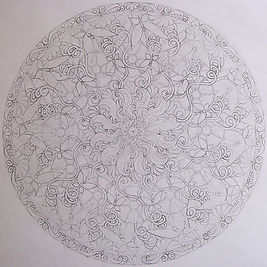
Mandalascapes.com
Mandalas by Prem Shashi
My mandalas
THESE MANDALAS ARE ESSENTIALLY an applied art: their primary function is as an aid to meditation, a sort of trap for the mind. Attracted by their vivid colours and the intricate tracery of their lines, the eye falls ensnared into a rhythmical spider’s web, dancing from line to line, while being ever drawn in towards the still point at the centre. Once engaged with the design, the mind also sets off on its own private healing journey through whatever lies encoded within the magic circle and its hidden harmonics.
They are also cosmic diagrams of the inner structures of the universe: the marvellous perpetual dance between dynamism and stillness that holds the forces of nature delicately in balance, a natural ordering of forms that is dazzlingly fine, but not quite infallible – there are always small irregularities in the hand-drawn geometries of my mandalas. A machine-generated image would lack this ability to reflect the ‘hand-drawn’ symmetries of nature itself, with all its infinite marginal variations on its own themes. The eye – one of nature’s most miraculous hand-drawn precision tools – generously overlooks such small irregularities on the whole, though the persistent will always find them.
The mandalas are all hand-drawn in pencil, working out from the centre (or, in a few instances, in from the circumference), on a grid of three, or more, concentric circles and a number of radiating lines. For a five-point mandala, there will be ten radiating lines, for an eight-point design there will be 16, and for a mandala with 12-fold symmetry, there will be 24 radiating lines in the grid.
Each element of the design is developed from what emerges when I allow my hand to doodle on the paper, so the mandalas grow outwards from the centre (or, in a few instances, in from the circumference), in a series of rings. There are no preparatory sketches. Until I reach the edge of the circle, I have no idea what the whole will look like, and I am often pleasantly surprised – very occasionally unpleasantly surprised – by the results.
This process of discovery is then repeated when I add the colours to the finished drawing – again I have no idea how it will look until I reach the outer edge of the design. Most of the mandalas are painted with gouache (the earlier ones were in watercolour or acrylic), or/and gel or felt pens.
For the series of smaller jewel-like mandalas, the drawing is picked out with metallic pen, and stick-on bindis (cosmetic ornaments worn on the forehead by Indian women) are added to the design. Where there are no metallic pen lines, the bindis were placed onto a pencil-drawn underlying grid.
To create the finished works seen here – and available for sale as prints – the hand-painted mandalas were scanned and made into digital files. I have then made a background for each design using the gradient option in Photoshop.
This practice originally emerged as a way to take the mandala design out to the edge of a square frame in the digital files. I took great pleasure in choosing colours and gradients that enhance the painted originals, however, and for me these computer-generated borders are an integral part of the finished artworks.
Although I persist in creating the mandalas entirely by hand, I see no reason not to take advantage of technology to achieve the perfectly smooth fades of colour in these backgrounds, which somehow offset the slightly less than absolutely regular quality of the mandalas. These borders would be merely laborious to produce by hand.

.jpg)


